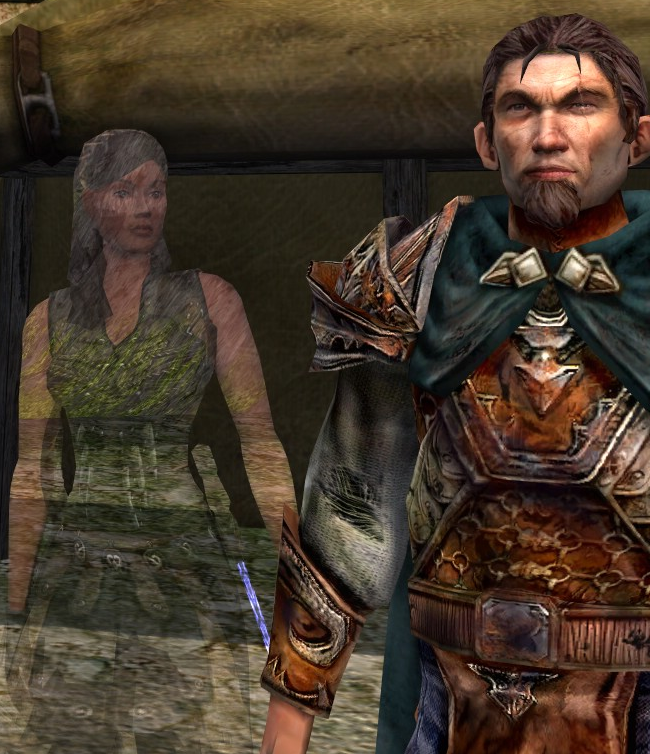 Just a few steps more and it is lights out for this creep…
Just a few steps more and it is lights out for this creep…
Oh, hey everyone! You all caught me while being sneaky, something we Burglars very much enjoy being. I am not sure why everyone insists on calling us Burglars, though. I have never stolen a thing in my life, honest!
So, you want to know what it is we do and how we go about doing it, you say? Well, we Scouts have three different techniques for Scouting, though all three overlap a fair amount.
There are general skills and guidelines that apply to all three techniques, but first let me list the three of them, where I feel they are best applied, and the main benefits of using that technique:
- The Quiet Knife: All on-level landscape tasks, quests and Tier 1 – 2 skirmishes, Tier 1 (and some T2) instances and Tier 1 raids (The greatest amount of instant damage)
- The Mischief-maker: Tier 2 Raids and some instances and skirmishes (Tier 3) (Crowd control, Debuffing, Fellowship-wide healing and power restoring)
- The Gambler: Soloing over-level quests and group instances or just to try something fun! (A bit of everything, with an emphasis on Damage over time)
Since most endeavors call for the Quiet Knife technique, I will discuss that first. As most know, with each technique comes benefits associated only with that technique, benefits unavailable to the other styles. These benefits are the defining aspects that make each technique what it is. Here are the benefits that come with being a Quiet Knife (these are the ‘line’ bonuses at the side of the Trait Window):
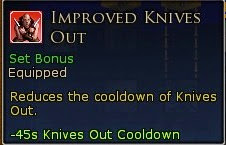 Knives Out is the Scout’s only direct area of effect damage skill
Knives Out is the Scout’s only direct area of effect damage skill
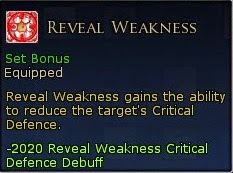 Critical Defense reduces how much damage critical hits end up doing
Critical Defense reduces how much damage critical hits end up doing
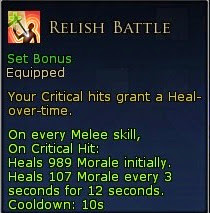 The Quiet Knife’s only self-heal… (crticals!)
The Quiet Knife’s only self-heal… (crticals!)
 Criticals… (is anyone noticing a pattern here?)
Criticals… (is anyone noticing a pattern here?)
So, you likely noticed that nearly every benefit to the Quiet Knife technique involves critical hits. The Quiet Knife line is largely devoted to two things: critical strikes and attacking from stealth. Notice that last benefit? It guarantees a critical strike when attacking from stealth with either of our two best skills for doing so: Surprise Strike and Cunning Attack.
Let’s go through some of the Quiet Knife’s main skills. For now, I will mainly focus on skills either devoted or largely influenced by the Quiet Knife technique, leaving the more general skills for later…
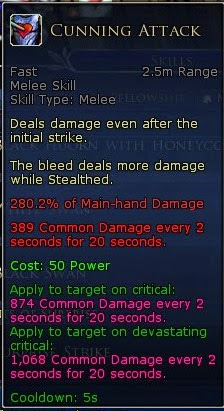
One of the Quiet Knife’s two best options from stealth

The second of the two stealth options
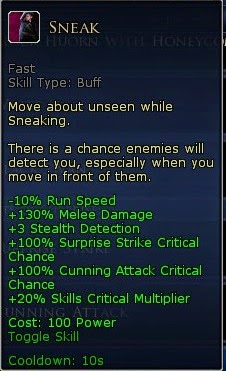
Notice all the benefits that come from striking from the shadows!

This skill guarantees a critical hit on your next attack

The Quiet Knife’s only area of effect attack. It can be used both offensively and defensively
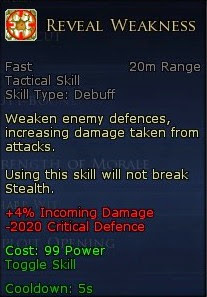
All three techniques allow a Scout to reveal weaknesses of a foe. The Quiet Knife also makes the foe more vulnerable to critical strikes
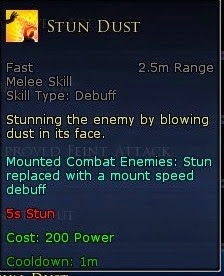
A way to incapacitate a foe, in order to gain time and position on him!
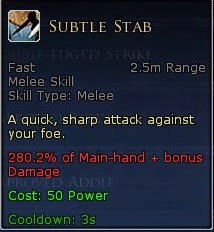
A very quick attack that will not slow you down in any way!

This is meant to be a finishing blow, one which will give a brief window to attack the next foe from stealth

The beginning of the Scout’s ‘critical chain’. Critical chain skills are skills that only become available after a critical strike is made. There are two stages to the chain: Openers (like Double-edged Strike), and Finishers (to be seen shortly!)
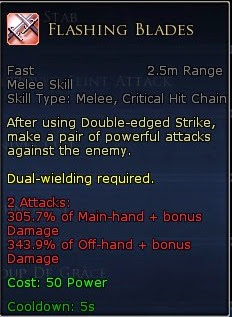
The Quiet Knife’s main critical chain finisher
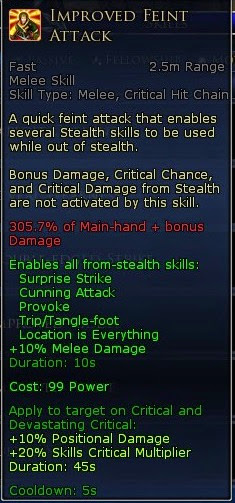
Feint Attack is part of the Quiet Knife’s critical chain. Once Improved Feint Attack is learned (the 6th of the 7 Quiet Knife line bonuses), it is no longer restricted to the chain but can be used at any time. Feint Attack allows the Quiet Knife to use many skills normally available only while sneaking and boosts many attacks that strike harder while sneaking. It also gives a +10% Melee Damage boost until one of those stealth-related attacks is used (up to 10 seconds)

All Scouts know how to Exploit Openings (a fellowship maneuver starter). Quiet Knives have an extra method for doing so while sneaking
If you are feeling overwhelmed, do not lose heart! So far this is mainly listing things for easy reference once we get to the heart of the matter. At the end of this essay, I will give tips for scouting in the field that will bring all of this together [with any luck! :)]
As can be seen, the emphasis on critical strikes we saw in the Quiet Knife line bonuses is furthered even more within their skills. We have a skill to guarantee a critical strike, a critical chain of skills only useable once a critical strike is achieved (and which are more powerful than most other skills), and a skill that improves all damage against a foe and weakens them even further to critical strikes. In the stealth department, we have skills that strike harder when in stealth, an extra fellowship maneuver starter only available while in stealth, and a skill that lets us feign stealth to a degree.
Many of the skills listed above come from the Quiet Knife tree, so I will not list them again here. However, let me cover a few of the benefits to be gained from the tree itself. As you will see, the thematic continuity of the Quiet Knife technique continues to be preserved:
Positional damage is something new (though astute readers will have already seen its mention before!). All Scouts, no matter what technique they employ, want to be striking at their foes from behind. It would be more accurate to say that all attackers should strike from behind where they can, but it is even more important that Scouts do so, and this extra Positional damage is only a very slight reason for doing so.
One last thing before we pull this all together. Higher level Scouts will have access to Legendary Items (where is that booing coming from?). Let’s have a quick look at what legacies are available to our weapons and scouting kits to see if we can draw any more ideas for how best to perform the Quiet Knife technique (legacies appropriate for Quiet Knives bolded):
- Burglar Weapon Legacies (Major)
- Burglar Bleed Damage (+1% – +15%)
- Critical Response Skill Damage (+1% – +10%)
- Cunning Attack Bleed Stack Chance (+3% – +66%)
- Position Surprise Strike from Stealth (+3% – +25%)
- Feint Attack Damage (+3% – +25%)
- Snag Damage Bonus (+3% – +25%)
- Subtle Stab Damage Multiplier (+1% – +10%)
- Surprise Strike Critical Rating (varies depending on level and quality of the weapon)
- Burglar Weapon Legacies (Minor)
- Coup de Grace Damage (+3% – +25%)
- Critical Chain Skills Critical Multiplier (+3% – +25%)
- Harmful Gamble Damage (+4% – +40%)
- Lucky Strike Damage (+3% – +25%)
- Riddle Range (+1 meter – +20 meters)
- Trick Range (+1 meter – +9 meters)
- Trick and Trick Removal Damage (+1% – +25%)
- Subtle Stab Critical Multiplier (+3% – +25%)
- Stat Legacies (Agility/Fate/Vitality) (varies, depending on level and quality)
Well, as you can see, no Quiet Knife would complain if they were to find a weapon with four, five, or even six Major legacies. Some quick explanation on these:
- Critical Response Skill Damage applies to all 3 Critical Chain skills listed above, and any others you might acquire
- The Cunning Attack Stack Chance applies only to non-critical, non-stealth attacks. Still, the extra damage adds up very well!
- Ideally, our critical rating will already be at or near cap, so we can avoid Surprise Strike Critical Rating for one of the other legacies
- Critical Chain Skills Critical Multiplier adds 25% extra damage to all critical hits when using the critical chain skills. Normally, a critical hit does 150% damage and a devastating critical hit 200%. With this legacy at full, those change to 175% and 225%, respectively.
- For all classes, changing a minor legacy to your main attribute (Agility for Scouts) is something to consider. With no legacy points spent at all, this will give a First Age 100th level weapon +149 Agility, which equates to +149 Crit Rating, +1,192 Physical Mastery, +447 Evade and +298 Parry, all while freeing up your points for legacies with a more linear progression
- Burglar Kit Legacies (Major)
- Critical Chain Skills Critical Chance (+1% – +15%)
- Devastating Critical Buff Duration (+3 seconds – +30 seconds)
- Off-hand Critical Rating (varies, depending on level and quality of the kit)
- Mischievous Glee Healing (+5% – +50%)
- Hedge Your Bet Damage (+3% – +25%)
- Gamble Chance (+5% – +20%)
- Positional Damage (+1% – +15%)
- Skills Critical Multiplier (+1% – +15%)
- Tricks Duration (+1 second – +15 seconds)
- Burglar Kit Legacies (Minor)
- All In Buff Duration (+1 second – +15 seconds)
- Coup de Grace Stealth Window (+1 second – +10 seconds)
- Increased Range for Reveal Weakness (+1 meter – +20 meters)
- Clever Retort Damage and Healing (+4% – +40%)
- Addle Induction Multiplier (+7% – +50%)
- Sneak Movement Speed (+1% – +10%)
- Pulse Modifier for Glee (+1 pulse – +9 pulses)
- Stealth Level (+1 level – +3 levels)
- Stat Legacies (Agility/Fate/Vitality) (varies, depending on level and quality)
Some explanations:
- Critical Chain Skills Critical Chance is not to be missed! (more on this later)
- You may have noticed that Feint Attack has the additional benefit of granting +10% Positional damage and a +20% Skills Critical Multiplier when it does a critical or devastating critical hit. Each Quiet Knife technique has a capstone skill that grants bonuses with a critical strike. What those benefits are varies with the capstone. Normally this bonus lasts for 15 seconds only, but the Devastating Critical Buff Duration increases the duration
- Off-hand Critical Rating (like Surprise Strike above) should be one of the first legacies we can set aside, since we should be able to get near the Critical Rating cap through other means
- Once Coup de Grace is used, if the foe falls in the next 4 seconds, the Quiet Knife will enter stealth briefly. The Coup de Grace Stealth Window legacy gives additional time to slay the foe before the opportunity to gain stealth is lost
- Quiet Knives move at 90% of their normal speed when sneaking. The Sneak Movement Speed legacy can boost that so that you sneak at your full running speed!
All right then! We have covered our skills, the powers we draw from the Quiet Knife technique and skill tree, and how our legendary items compliment them. Now it is time to put it to use in the field!
Pulling it all together
- The best way to open a combat is from stealth. A Surprise Strike (for foes with lesser morale) or a Cunning Attack (for foes with larger morale to take advantage of the bleed) is a great way to begin. However, it always pays to think outside the kit, so to speak. Using Aim and then Coup de Grace guarantees each of Coup de Grace’s three attacks will strike critically, dealing a great amount of damage. If the fight will be a longer one (over 1 minute) this also allows Coup de Grace to be ready again sooner. Finally, Coup de Grace does not seem to break stealth immediately, so a quick follow up with Surprise Strike, or ideally Cunning Attack (since the foe will be turning toward us now and the bleed amount is independent of facing), will pile on more damage to the creep
- Once you have done all you can from stealth, Feint Attack/Improved Feint Attack is a good way to continue. Each subsequent attack afterward (for up to 10 seconds) will get the +10% melee damage bonus Feint Attack gives
- Hopefully by now you have opened up your critical chain with a critical hit. At this point, you mostly want to keep to the critical chain skills if you can. Let me briefly summarize all the benefits that apply only to the critical chain skills that can be earned from the Quiet Knife line, fruit from its tree, and legendary items:
- All critical chain skills bypass 10% of the foe’s mitigation
- +20% damage to all critical chain skills (10% from Dance of Blades from the tree and 10% from the legacy), +45% to Feint Attack (from its additional +25% damage legacy)
- Every critical chain skill has a 45% chance to lower the foe’s Critical Defense by 5% for 8 seconds. While this is not a cumulative effect (it will not go lower than 5%), the timer is renewed every time the chance is met thereafter. With the ease of critical striking for Quiet Knife scouts, this is effectively a +5% Skills Critical Multiplier for every person striking that foe
- +25% Critical Magnitude to all critical chain skills (from the legacy)
- +15% chance to strike critically with critical chain skills (from the amazing legacy)
- +10 Positional Damage and +20% Skills Critical Multiplier for 15 seconds (longer with the legacy) from striking critically with Feint Attack
- If only there were more than our three critical chain skills (Feint Attack, Double-edged Strike, and Flashing Blades) to take advantage of all these critical chain benefits… and there is! A dip of 12 points into the Gambler line will grant:
- With Gambler’s Advantage, we now have four critical chain skills, each of which has only a 5 second cooldown. As long as we are continually landing critical strikes, these skills will be available to us to wreak havoc on the Enemy’s forces
- I might cover what sort of equipment to look for in a later installment but, before we finally leave critical chain skills behind, let me mention one more thing. There is a set of jewelry, attainable only in the Epic Battles [where is that booing coming from? :)], that grants the following set bonus:
- The highest chance for a Quiet Knife to strike with a critical hit with normal scouting skills is: +25% (from a capped Critical Rating) + 5% (from Deft Strikes in the Quiet Knife tree) + 10% (from the Epic Battle jewelry, if the 10% chance is met) = 40%. With the Critical Chain Skills Critical Chance legacy, the chance for a critical hit with the critical chain skills is 55%.
- As for skills outside the critical chain skills, Improved Feint attack gives its +10% Melee Damage bonus for 10 seconds (or until a stealth-enhanced skill is used), but the skill itself only has a 5 second cooldown. With the legacies boosting its damage, we want to be using Feint Attack whenever we can. So, just before Feint Attack is ready to be used again, a Surprise Strike (for foes with lower morale) or a Cunning Attack (for foes with higher morale) will give us full benefit of Feint Attack’s stealth enhancement, just in time to regain it with another Feint Attack!
- Remember, however, that only non-stealth, non-critical attacks can be stacked with the Cunning Attack Bleed Stack Chance legacy. Therefore, after a Surprise Strike from stealth, before using Feint Attack to regain the stealth enhancement, a quick non-stealthed Cunning Attack will have its full chance to put an additional bleed on the foe. In longer fights, it is a good idea to alternate between Surprise Strike (10 second cooldown) and Cunning Attack (5 second cooldown), being sure to follow up any Surprise Strike with a Cunning Attack out of stealth, before using Feint Attack to regain its bonuses
- Lastly, you will have likely noticed that every single attack we Scouts have is a ‘Fast’ attack. When it comes to fast-paced combat and striking quickly, we Quiet Knives have few equals. Even so, there are fast attacks and there are fast attacks, with Flashing Blades and Subtle Stab at the slow and fast ends of the spectrum, respectively. A Subtle Stab is virtually instantaneous and, as such, should be used whenever it is ready (3 second cooldown). The Quiet Knife that is able to deftly mix Subtle Stab into their dance of war is a true force to be reckoned with!
I hope this guide to the Quiet Knife Scouting technique has been useful! Scouting is no easy task, so try not to let things overwhelm you. Learning a bit here and a bit there will add up, and those new to the craft will find themselves well along the path to mastery before they know it!
The Quiet Knife technique is the technique most applicable to the everyday situations in which we Scouts will find ourselves, though personal taste and preference should always come first, of course! In our next installment, we will discuss the Mischief-maker, and why it is more fun to be surrounded by friends to witness any Mischief you create! See you soon!
(dedicated to all Papa Hobbits, Mama Hobbits, and Baby Hobbits, everywhere)




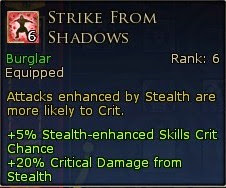


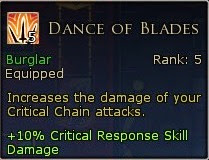





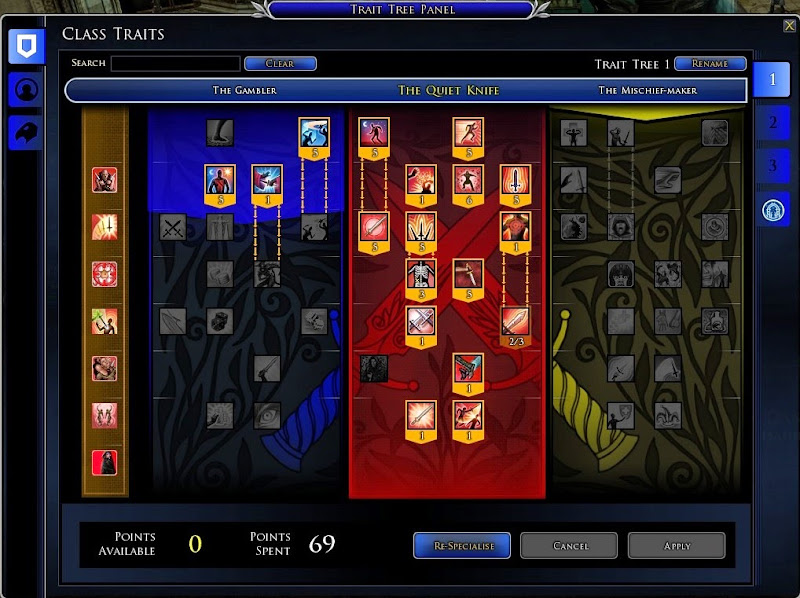



An outstanding guide as always! Started replaying my Mischief-maker recently and can’t wait for your guide on that spec.
Thanks so much! I am hoping to get the Mischief-maker done by the end of the week, or early next week, depending
What a great guide! I hadn’t realised just quite how much burst damage potential quick knife burglars had, but it sounds like it would be fun to try. How do you deal with large groups of mobs though? Kiting? CC? My little burglar is also a mischief-maker so any tips for that spec would be appreciated.
Mostly mischief maker nowadays (so much fun!) but QKing if my friends need a fake offtanker crazy dpsing hobbit! With groups of elite mobs I’ll use a combo of stun dust, riddle and exploit opening to stun them and attack one at a time while with trashy mobs I just keep stabbing away (though Corsairs love to run away from my burglar hobbit so I’ll let them bleed+riddle away)
Thank you for your kind words!
Elyse has some good ideas for large groups. Aim + Knives Out is also good, if they are melee mobs, as you can get a good shot in on three of them, and for 10 seconds afterward you are only taking 20% damage from any blow, so it takes 5 hits on you to equal just one. Your foes are also hurting themselves in the process and will fall more easily
Two skills I have not covered yet, since they are more general skills are Touch and Go and Ready and Able. Touch and Go gives an additional +50% chance to evade any attack for 30 seconds (5 minute cooldown) and Ready and Able resets most, if not all, of the Scouts’ cooldowns (also a 5 minute cooldown). So, between those two skills, you can evade nearly all attacks for a minute or so, which hopefully will be long enough to give you the upper hand!
My guide for the Mischief-maker will be coming ‘soon’ (hopefully within a week or so). I hope this helps!
A very good primer for the aspiring Bur…er…Scout Miss Kaleigh. My baby scout is not yet big enough to take full advantage of the guide but it is helpful none-the-less. I do like that you included LI choices and commentary as this is an important part of later game play.
A question though. On the LI legacies you say that 6 majors would not be unwelcome, but are there actually enough points to spread to that many or do you prioritize maxing certain ones over others?
Thank you, Tale-Spinner! And you ask a very good question.
The most legacies any legendary item can have at present is 7 (6 from normal advancement, and 1 from a Crystal of Remembrance), so there will be tough choices to be made as far as what legacies to leave behind. This will actually be even tougher with the other two Scouting techniques, as they have additional legacies besides damage-based legacies to consider.
With my Quiet Knife sticker, I have the following legacies to the following ranks:
– Burglar Bleed Damage – +13% (8)
– Feint Attack Damage – +25% (9)
– Subtle Stab Damage Multiplier – +10% (9)
– Cunning Attack Bleed Stack Chance – +58% (8)
– Critical Response Skill Damage – +10% (9)
– Critical Chain Skills Critical Multiplier – +25% (9)
– +152 Agility (2)
So, besides the Agility Legacy, the other legacies are fully ranked, save for two missing just one rank each.
I was able to manage this due to this being a First Age weapon, with a Scroll of Delving that gives 10 additional levels worth of legacy points, raising the total available to 830. Also, the Agility legacy gives almost its full worth just by being present, saving legacy points to spend elsewhere. Lastly, since inherent DPS on this sticker only raises by 1 DPS for each rank, I only raised that to Rank 4, saving more points for the other legacies.
For lower-level scouts with Second and Third Age weapons, it will not be possible to cover everything this thoroughly, of course. In cases where you have to prioritize to a greater degree, I would put more emphasis on legacies that affect multiple skills (like the legacies that apply to all critical chain skills) and I would recommend taking advantage of the lower costs for lower ranks in legacies and spread points around more evenly. That way, you can get more from your points than just putting all points into one or two things.
Those two ideas are at odds with each other, of course, so it will always be a matter of gaining something to lose something else. But there should be a happy medium in there somewhere!
I hope this helps!
Excellent work! My burglar will be slogging to level 100 after my champion gets there tomorrow, and I will keep this page open.
One thing I do is to keep two burglar kits on my hotbar. One has the Stealth and Sneak bonuses to get me in position for that vital first strike. The other is all damage-enhancing, and I switch to it as soon as I stab the first guy.
Thank you!
That is smart thinking, about keeping a separate kit for sneaking around
Can you provide more details on how to get the jewellery from the epic battles? I bypassed Helms deep but am thinking I should go back to get the jewellery.
Certainly!
If you go to your ‘Battle for Helm’s Deep’ panel and then choose the lowest tab on the left, you will come to your ‘Battle History’ panel. At the top is a record of the best medal you have won in each battle, and in each side objective of that battle. To the right of that is your Lifetime medal total, with your lifetime side objective total below that.
The bottom of the panel is where you want to look. There you will see four different medal types with a tracking bar for each. If you mouse over one of the bars, it will likely say ‘0/20’, since you have not done any of the battles up to now.
The way this works is you need 20 medals of a certain type in order to get a reward of that type. Iron medals reward basic jewelry (Yellow) for your level, Silver medals reward purple jewelry, Gold rewards teals (but without the set bonuses), and Platinum rewards identical teals to the Gold rewards, but with the set bonuses.
If you successfully complete a side objective in a battle or the battle itself, you will be rewarded medals for your progress bar, based on what quality of medal you earned. You also earn medals of each type below the one you actually earned as well. So, if you were awarded a Platinum medal for a side objective, you would actually earn 1 Iron medal, 1 Silver medal, 1 Gold medal, and the 1 Platinum medal. These will be added to the progress of your bar for each type of medal, and when it reaches the end (20 medals), you will be given a reward of that type.
To the right of the first 2 bars, you will see two icons. The top one gives you the option to have medals of that type apply to the next highest reward progress bar rather than give out rewards of that type. I would highly recommend setting both Iron and Silver to ‘forward’ into Gold rewards, as the quality of the teals is much better, and once you have them, you would not really want the lower quality ones. Forwarding stops with the Gold medals, though. The only way to earn Platinum medals is to be awarded them in the battles.
The number of medals you earn for each side objective depends on the size of the battle (the number of players it is for) There is a multiplier for each size upward (sizes being 1-2, 3, 6, and 12 players)
For instance, if you completed a side objective in a solo/duo battle, you would earn 1 medal. Completing a side objective in the 3-person battle (Glittering Caves) would earn 2 medals for everyone in the battle. The 6-person battle (Helm’s Dike) awards 3, and the Raid-sized battle (Deeping Wall) awards 4.
In addition to this, you will be given a medal for your overall performance for the battle itself. A platinum medal for the overall battle requires earning platinum medals for every side quest in addition to not losing any soldiers, banners, or commanders. The number of medals awarded for the overall battle is equal to total number awarded for all side objectives.
For example, say you did a solo battle at Helm’s Dike. There are always 3 side objectives in this battle, for which we will say you earned Silver, Gold, and Platinum on respectively.
The total number of medals you would earn would be:
– 1 Silver and 1 Iron (for the Silver objective)
– 1 Gold, 1 Silver and 1 Iron (for the Gold objective)
– 1 Platinum, 1 Gold, 1 Silver and 1 Iron (for the Platinum objective)
…and 3 for the overall battle, depending on what medal you earned for it. It would not be Platinum, since you need to earn all Platinums on all side objectives to get a Platinum one for the overall medal, but a Gold overall medal is possible If that were the case, the reward would be:
If that were the case, the reward would be:
– 3 Gold, 3 Silver and 3 Iron (equal to the total possible medals able to be earned in the side objectives)
So the total medals earned between the overall battle and its side objectives would be: 1 Platinum, 5 Gold, 6 Silver, and 6 Iron. These would go into your progress bars for each medal type and give out rewards if any of them made it to 20 medals, where upon they would start again from 0 with any remaining medals applying to the progress bar once again.
The best possible outcome is to sweep Platinum medals at the Deeping Wall raid battle, which also always has 3 side objectives. In this case, the reward would be:
4 Platinum medals, 4 Gold medals, 4 Silver medals and 4 Iron medals (1 multiplied by 4 due to the size of the battle), for each objective. Therefore, 12 of each medal type for the three side objectives total. Then another 12 for the overall, since the reward for that equals the number possible in all the side objectives together. So, the final payout would be:
24 Platinum medals, 24 Gold Medals, 24 Silver medals and 24 Iron medals, which is very nice!
In this case, you would be given a reward for each medal type (maybe more if you are forwarding Iron and Silver rewards toward Gold rewards. The platinum reward will be a teal with the set bonuses you are seeking. Exactly which piece of jewelry (amongst the possible teals) is completely random, so it may take a bit to complete your set.
I hope this helps! There are some good guides on the forums for ways to do well in the battles. The better the medals you earn, the more ‘promotion points’ you earn to put into the three disciplines for the battles (Engineer, Officer and Vanguard). You start off slow but, with some of those promotions, you will be able to do more and more
Lastly, if you really just want the jewelry, and you can live with level 95 jewelry pieces, one of the Quartermasters in Helm’s Deep now has all the teal pieces with the set bonuses for barter (2,054 Marks and 592 Medallions per piece).
Good luck out there!
This was still helpful today.
Will you ever release the other 2 parts of this guide?